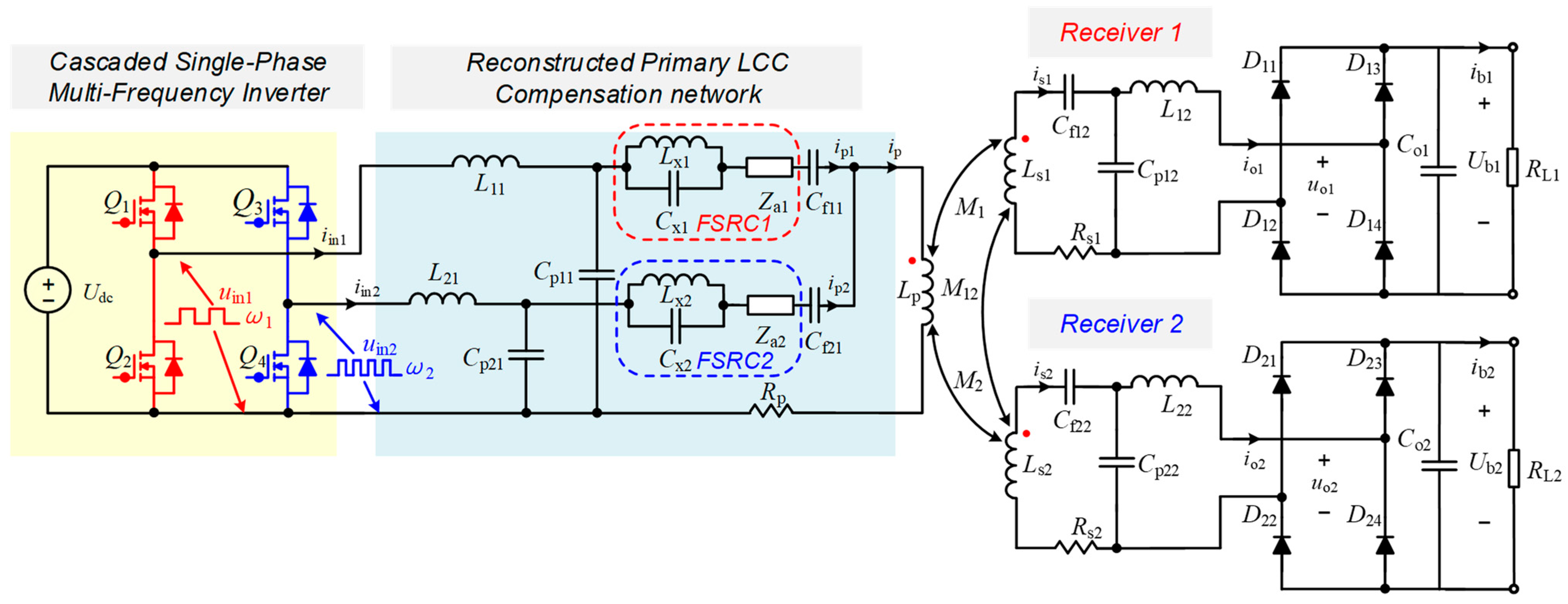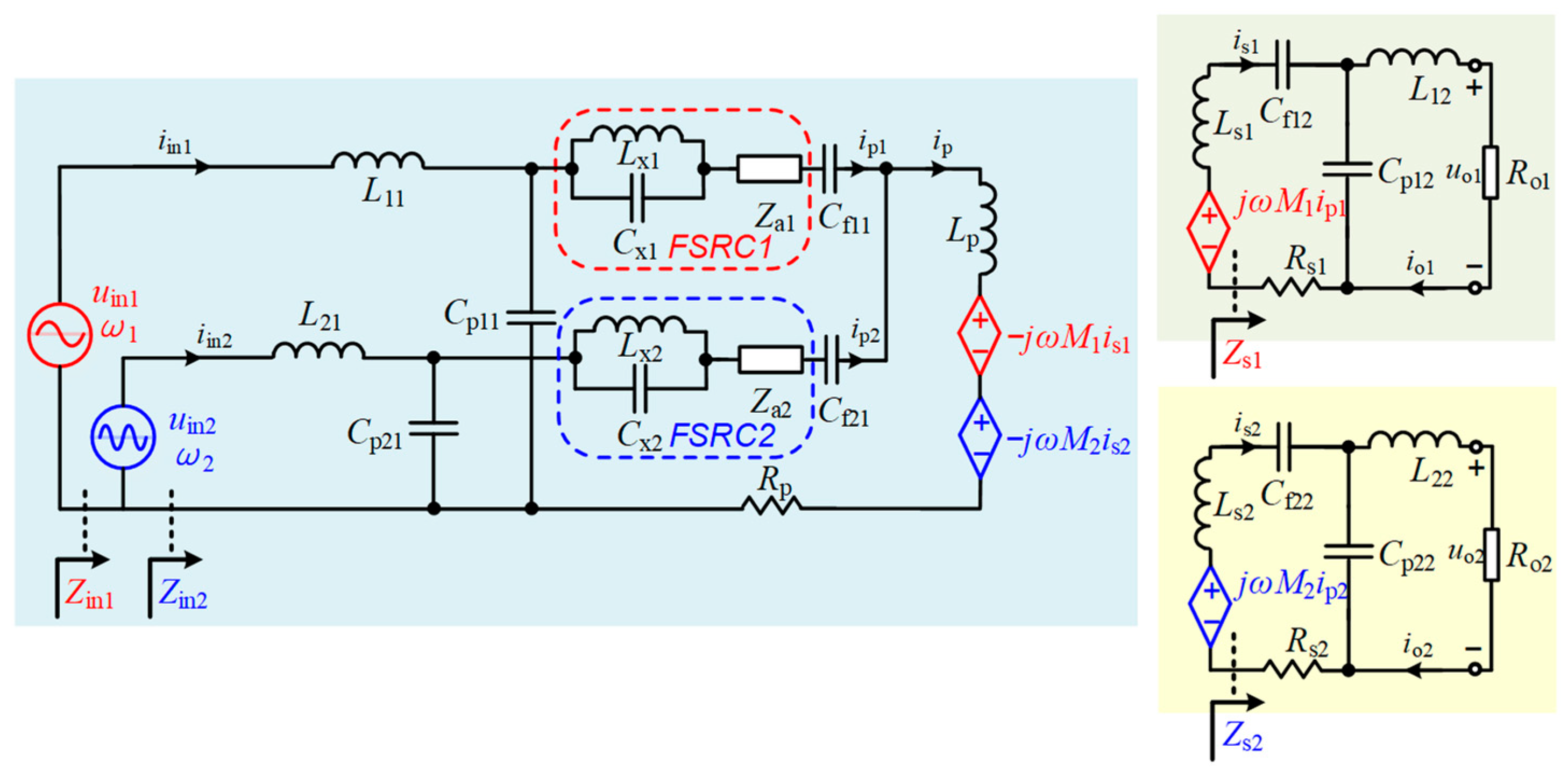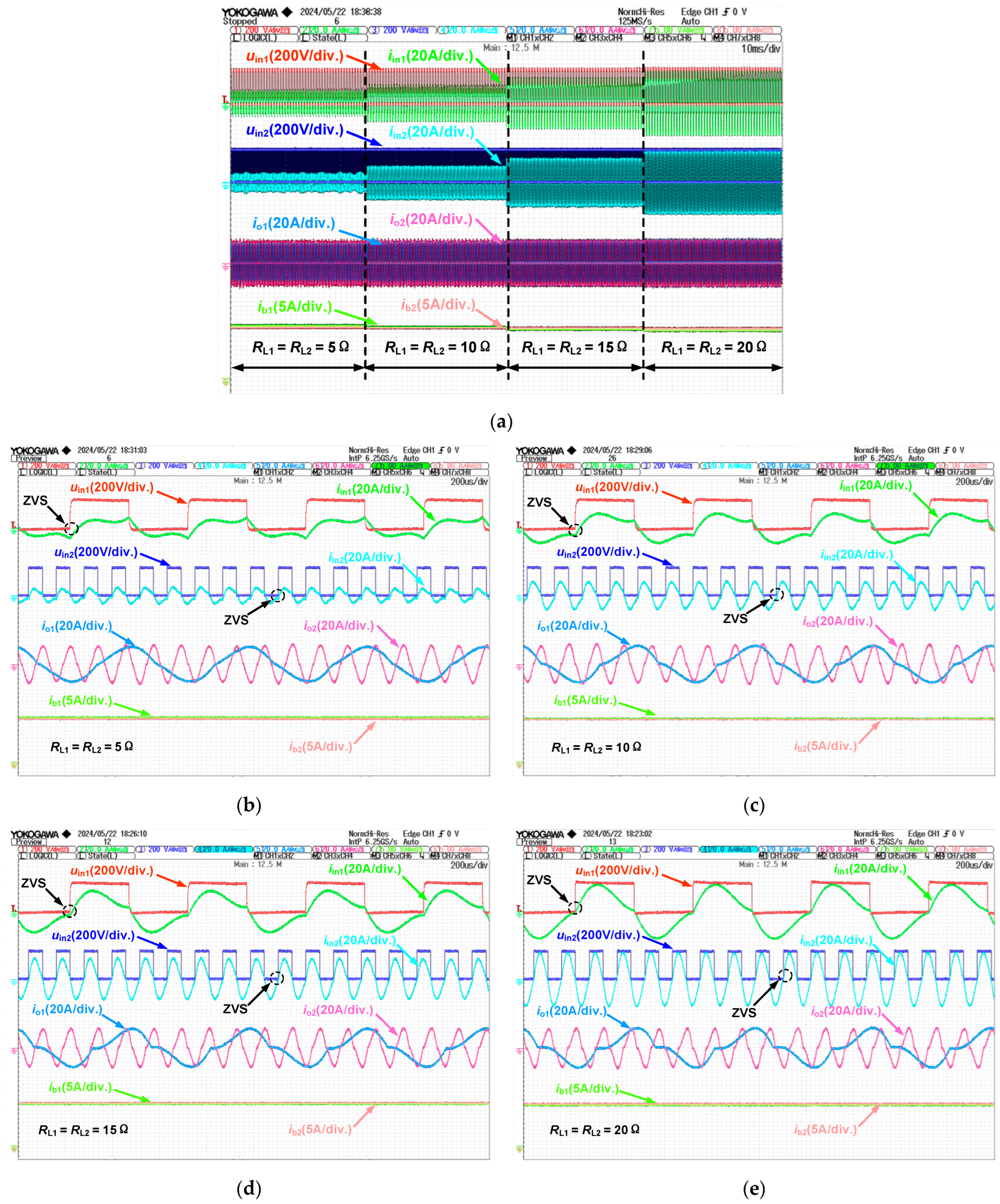An Integrated Double-Sided LCC Compensation Based Dual-Frequency Compatible WPT System with Constant-Current Output and ZVS Operation
Abstract
1. Introduction
2. Theoretical Analysis of the Proposed Dual-Frequency Compatible WPT System
3. Working Principle and Parameter Design Criteria of the FSRC Network
4. Parameter Design Method of the Proposed Dual-Frequency WPT System
5. Experimental Verification
6. Comparison and Discussion
- (1)
- This article reconstructed the conventional DS-LCC compensated WPT system by using CSMI and FSRC, the load-independent CCO property and ZVS operation at two specified frequencies can be implemented simultaneously.
- (2)
- The proposed method has low design complexity and can significantly improve the system efficiency, and can be applied to multi-frequency and multi-load wireless charging with higher power level.
7. Conclusions
Author Contributions
Funding
Data Availability Statement
Conflicts of Interest
References
- Zhang, Z.; Li, Z.; Zhang, X.; Yang, B.; He, Z.; Mai, R.; Chen, Y. A dynamic wireless power transfer system using DC controlled variable inductor for segment transmitter automatic switching. IEEE Trans. Power Electron. 2024, 1–5. [Google Scholar] [CrossRef]
- Chen, Y.; Zhang, Z.; Yang, B.; Zhang, B.; Fu, L.; He, Z.; Mai, R. A clamp circuit-based inductive power transfer system with reconfigurable rectifier tolerating extensive coupling variations. IEEE Trans. Power Electron. 2023, 39, 1942–1946. [Google Scholar] [CrossRef]
- Li, Z.; Liu, H.; Huo, Y.; He, J.; Tian, Y.; Liu, J. High-misalignment tolerance wireless charging system for constant power output using dual transmission channels with magnetic flux controlled inductors. IEEE Trans. Power Electron. 2022, 37, 13930–13945. [Google Scholar] [CrossRef]
- Chen, Y.; Wu, J.; Zhang, H.; Guo, L.; Lu, F.; Jin, N.; Kim, D.H. A parameter tuning method for a double sided LCC compensated IPT system with constant voltage output and efficiency optimization. IEEE Trans. Power Electron. 2023, 38, 4124–4139. [Google Scholar] [CrossRef]
- Chen, Y.; Zhang, H.; Jin, N.; Guo, L.; Wu, J.; Park, S.-J.; Kim, D.-H. A unipolar-duty-cycle hybrid control strategy of series–series compensated IPT system for constant-current output and efficiency optimization. IEEE Trans. Power Electron. 2022, 37, 13884–13901. [Google Scholar] [CrossRef]
- Lu, C.; Huang, X.; Rong, C.; Tao, X.; Zeng, Y.; Liu, M. A dual-band negative permeability and near-zero permeability metamaterials for wireless power transfer syste. IEEE Trans. Ind. Electron. 2021, 68, 7072–7082. [Google Scholar] [CrossRef]
- Liao, Z.-J.; Zhu, Q.-W.; Yu, Y.; Xia, C.-Y.; Rong, C.-C. Analysis and design of self-oscillating magnetic coupling wireless power transfer systems. IEEE J. Emerg. Sel. Top. Power Electron. 2024, 12, 1140–1149. [Google Scholar] [CrossRef]
- Zhou, W.; Chen, Z.; Zhang, Q.; Li, Z.; Huang, L.; Mai, R.; He, Z. Design and analysis of CPT system with wide-range ZVS and constant current charging operation using 6.78 MHz Class-E power amplifier. IEEE J. Emerg. Sel. Top. Power Electron. 2024, 12, 3211–3225. [Google Scholar] [CrossRef]
- Cai, C.; Wang, J.; Zhao, Y.; Luo, Y.; Yuan, Z.; Xue, M.; Rao, Y.; Yang, L.; Hong, Y.; Wang, C. Hybrid interference field mitigation of dual-rectangular transmitter pad for universal wireless charging area expansion. IEEE Trans. Transport. Electrific. 2024, 10, 3816–3827. [Google Scholar] [CrossRef]
- Li, H.; Liu, M.; Kong, L.; Wang, Y. An independent dual-coil driving topology for wireless power transfer. IEEE Trans. Power Electron. 2023, 38, 1378–1383. [Google Scholar] [CrossRef]
- Li, Y.; Mai, R.; Lu, L.; Lin, T.; Liu, Y.; He, Z. Analysis and transmitter currents decomposition based control for multiple overlapped transmitters based WPT systems considering cross couplings. IEEE Trans. Power Electron. 2018, 33, 1829–1842. [Google Scholar] [CrossRef]
- Liu, X.; Gao, F.; Wang, T.; Khan, M.M.; Zhang, Y.; Xia, Y.; Wheeler, P. A multi-inverter multi-rectifier wireless power transfer system for charging stations with power loss optimized control. IEEE Trans. Power Electron. 2023, 38, 9261–9277. [Google Scholar] [CrossRef]
- Luo, C.; Qiu, D.; Zhang, B.; Xiao, W.; Chen, Y. Wireless power transfer system for multiple loads. Trans. China Electrotech. Soc. 2020, 35, 2499–2516. [Google Scholar]
- Liu, Z.; Su, M.; Zhu, Q.; Chao, Y.; Zang, S.; Hu, A.P. A dual-frequency 3-D WPT system with directional power transfer capability at two separately regulated outputs. IEEE J. Emerg. Sel. Top. Power Electron. 2023, 11, 2514–2524. [Google Scholar] [CrossRef]
- Zhang, X.; Liu, F.; Mei, T. Multifrequency phase-shifted control for multiphase multiload MCR WPT system to achieve targeted power distribution and high misalignment tolerance. IEEE Trans. Power Electron. 2021, 36, 991–1003. [Google Scholar] [CrossRef]
- Huang, Y.; Liu, C.; Xiao, Y.; Liu, S. Separate power allocation and control method based on multiple power channels for wireless power transfer. IEEE Trans. Power Electron. 2020, 35, 9046–9056. [Google Scholar] [CrossRef]
- Liu, F.; Yang, Y.; Ding, Z.; Chen, X.; Kennel, R.M. A multifrequency superposition methodology to achieve high efficiency and targeted power distribution for a multiload MCR WPT system. IEEE Trans. Power Electron. 2018, 33, 9005–9016. [Google Scholar] [CrossRef]
- Xia, C.; Wei, N.; Zhang, H.; Zhao, S.; Li, Z.; Liao, Z. Multifrequency and multiload MCR-WPT system using hybrid modulation waves SPWM control method. IEEE Trans. Power Electron. 2021, 36, 12400–12412. [Google Scholar] [CrossRef]
- Qi, C.; Huang, S.; Chen, X.; Wang, P. Multifrequency modulation to achieve an individual and continuous power distribution for simultaneous MR-WPT system with an inverter. IEEE Trans. Power Electron. 2021, 36, 12440–12455. [Google Scholar] [CrossRef]
- Gao, X.; Du, B.; Zhang, Y.; Cui, S. A dual-frequency compatible wireless power transfer system with a single transmitter and multiple receivers. IEEE Access 2022, 10, 102564–102574. [Google Scholar] [CrossRef]
- Liu, Y.; Liu, C.; Huang, R.; Song, Z. Primary multi-frequency constant-current compensation for one-to-multiple wireless power transfer. IEEE Trans. Circuits Syst. II Exp. Briefs 2023, 70, 2201–2205. [Google Scholar] [CrossRef]
- Liu, Y.; Liu, C.; Gao, X.; Liu, S. Design and control of a decoupled multichannel wireless power transfer system based on multilevel inverters. IEEE Trans. Power Electron. 2022, 37, 10045–10060. [Google Scholar] [CrossRef]
- Pang, H.; Chau, K.T.; Han, W.; Liu, W.; Zhang, Z. Decoupled-double D coils based dual-resonating-frequency compensation topology for wireless power transfer. IEEE Trans. Magn. 2022, 58, 1–7. [Google Scholar] [CrossRef]
- Thenathayalan, D.; Park, J.-H. Individually regulated multiple-output WPT system with a single PWM and single transformer. IEEE J. Emerg. Sel. Top. Power Electron. 2020, 8, 3542–3557. [Google Scholar] [CrossRef]
- Zhang, Z.; Zhang, B. Angular-misalignment insensitive omnidirectional wireless power transfer. IEEE Trans. Ind. Electron. 2020, 64, 2755–2764. [Google Scholar] [CrossRef]
- Kim, Y.-J.; Ha, D.; Chappell, W.J.; Irazoqui, P.P. Selective wireless power transfer for smart power distribution in a miniature-sized multiple-receiver system. IEEE Trans. Ind. Electron. 2016, 63, 1853–1862. [Google Scholar] [CrossRef]
- Zhang, Z.; Pang, H. Continuously adjustable capacitor for multiple-pickup wireless power transfer under single-power-induced energy field. IEEE Trans. Ind. Electron. 2020, 67, 6418–6427. [Google Scholar] [CrossRef]
- Hou, X.; Wang, Z.; Su, Y.; Liu, Z.; Deng, Z. A dual-frequency dual-load multi-relay magnetic coupling wireless power transfer system using shared power channel. IEEE Trans. Power Electron. 2022, 37, 15717–15727. [Google Scholar] [CrossRef]
- Pang, H.; Chau, K.T.; Liu, W.; Tian, X. Multi-resonating compensation for multi-channel multi-pickup wireless power transfer. IEEE Trans. Magn. 2022, 58, 1–6. [Google Scholar] [CrossRef]
- Cheng, C.; Zhou, Z.; Li, W.; Zhu, C.; Deng, Z.; Mi, C.C. A multi-load wireless power transfer system with series-parallel-series compensation. IEEE Trans. Power Electron. 2019, 34, 7126–7130. [Google Scholar] [CrossRef]










| Note | Symbol | Value |
|---|---|---|
| Resonance frequency of FSRC 1 | f1 | 20 kHz |
| Resonance frequency of FSRC 2 | f2 | 85 kHz |
| Parallel resonant inductance of FSRC 1 | Lx1 | 50 µH |
| Parallel resonant inductance of FSRC 2 | Lx2 | 50 µH |
| Parallel resonant capacitance of FSRC 1 | Cx1 | 70.12 nF |
| Parallel resonant capacitance of FSRC 2 | Cx2 | 1266.51 nF |
| Series resonant capacitance of FSRC 1 | Ca1 | 1196.40 nF |
| Series resonant inductance of FSRC 2 | La2 | 2.93 µH |
| Note | Symbol | Value |
|---|---|---|
| DC-link input voltage | Udc | 150 V |
| Resonance frequency of channel 1 | f1 | 20 kHz |
| Resonance frequency of channel 2 | f2 | 85 kHz |
| Charging current of channel 1 | Ib1 | 6 A |
| Charging current of channel 2 | Ib2 | 6 A |
| Primary coil inductance | Lp | 364.3 µH |
| Secondary coil inductance of channel 1 | Ls1 | 227.1 µH |
| Secondary coil inductance of channel 2 | Ls2 | 227.1 µH |
| Mutual inductance of channel 1 | M1 | 41.42 µH |
| Mutual inductance of channel 2 | M2 | 41.42 µH |
| Note | Symbol | Value |
|---|---|---|
| Dual-side resonant inductances of channel 1 | L11 & L12 | 57.79 µH |
| Dual-side resonant inductances of channel 2 | L21 & L22 | 28.03 µH |
| Dual-side parallel resonant capacitances of channel 1 | Cp11 & Cp12 | 1095.8 nF |
| Dual-side parallel resonant capacitances of channel 1 | Cp21 & Cp22 | 125.1 nF |
| Primary series resonant capacitances of channel 1 | Cf11 | 190.0 nF |
| Primary series resonant capacitances of channel 2 | Cf21 | 9.5 nF |
| Secondary series resonant capacitances of channel 1 | Cf12 | 374.0 nF |
| Secondary series resonant capacitances of channel 2 | Cf22 | 17.6 nF |
| Parameter | Value |
|---|---|
| Air gap distance Turns per coil | 100 mm Np: 21; Ns1: 30; Ns2: 30 |
| Primary coil dimensions | 790 mm × 240 mm (Outer size) 660 mm × 110 mm (Inner size) |
| Secondary coil dimensions | 230 mm (Outer size); 70 mm (Inner size) |
| Litz wire dimensions | AWG 9 (2.91 mm) |
| Secondary coil center distance Primary coil inductance Lp Secondary coil inductance of channel 1 Ls1 Secondary coil inductance of channel 2 Ls2 Coupling coefficient between transmitter and receiver 1 k1 Coupling coefficient between transmitter and receiver 1 k2 Coupling coefficient between receiver 1 and 2 k12 | 600 mm 362.9 µH 228.3 µH 228.3 µH 0.145 0.143 0.003 |
| Reference | Multi-Frequency Superposition Method | Maximum Efficiency | ZVS Operation | Operating Frequency | CV/CC | Topology Structure | Design Complexity | Rating POWER |
|---|---|---|---|---|---|---|---|---|
| [16] | Integration of multiple inverters via transformers | 80% | Yes | 176.7 kHz & 206.3 kHz | No | LCL-S | High | 65 W |
| [17] | 86.7% | Yes | 190 kHz & 210 kHz | No | S-S | High | 100 W | |
| [18] | Hybrid modulation waves sinusoidal pulse width modulation | 70% | No | 20 kHz & 80 kHz | CC | S-S | Medium | 40 W |
| [19] | 85% | No | 100 kHz & 200 kHz | No | S-S | Medium | 120 W | |
| [20] | 88% | No | 20 kHz & 85 kHz | CV | LCC-S | Medium | 100 W | |
| [21] | Neutral point clamped-multilevel inverters | 78.9% | No | 100 kHz & 300 kHz | CV | LCC-S | Medium | 125 W |
| [22] | 89.3% | No | 100 kHz & 200 kHz | CV | LCC-S | Medium | 1000 W | |
| This article | Cascaded single-phase multi-frequency inverter | 91.75% | Yes | 20 kHz & 85 kHz | CC | DS-LCC | Low | 1500 W |
Disclaimer/Publisher’s Note: The statements, opinions and data contained in all publications are solely those of the individual author(s) and contributor(s) and not of MDPI and/or the editor(s). MDPI and/or the editor(s) disclaim responsibility for any injury to people or property resulting from any ideas, methods, instructions or products referred to in the content. |
© 2024 by the authors. Licensee MDPI, Basel, Switzerland. This article is an open access article distributed under the terms and conditions of the Creative Commons Attribution (CC BY) license (https://creativecommons.org/licenses/by/4.0/).
Share and Cite
Chen, Y.; Liu, Y.; Yang, Z.; Gao, P.; Wu, J. An Integrated Double-Sided LCC Compensation Based Dual-Frequency Compatible WPT System with Constant-Current Output and ZVS Operation. Electronics 2024, 13, 3714. https://doi.org/10.3390/electronics13183714
Chen Y, Liu Y, Yang Z, Gao P, Wu J. An Integrated Double-Sided LCC Compensation Based Dual-Frequency Compatible WPT System with Constant-Current Output and ZVS Operation. Electronics. 2024; 13(18):3714. https://doi.org/10.3390/electronics13183714
Chicago/Turabian StyleChen, Yafei, Yijia Liu, Zhiliang Yang, Pengfei Gao, and Jie Wu. 2024. "An Integrated Double-Sided LCC Compensation Based Dual-Frequency Compatible WPT System with Constant-Current Output and ZVS Operation" Electronics 13, no. 18: 3714. https://doi.org/10.3390/electronics13183714
APA StyleChen, Y., Liu, Y., Yang, Z., Gao, P., & Wu, J. (2024). An Integrated Double-Sided LCC Compensation Based Dual-Frequency Compatible WPT System with Constant-Current Output and ZVS Operation. Electronics, 13(18), 3714. https://doi.org/10.3390/electronics13183714







